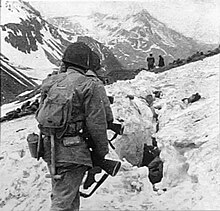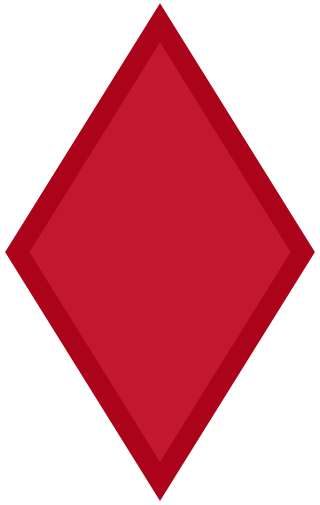
The 5th Infantry Division (Mechanized)—nicknamed the "Red Diamond", or the "Red Devils" —was an infantry division of the United States Army that served in World War I, World War II and the Vietnam War, and with NATO and the U.S. Army III Corps. It was inactivated on 24 November 1992 and reflagged as the 2nd Armored Division.

The 89th Infantry Division, originally known as the "89th Division," was an infantry formation of the United States Army that was active during World War I, World War II, and the Cold War.

The 102nd Infantry Division ("Ozark") was a unit of the United States Army in World War II. The unit is currently active as the 102nd Training Division (Maneuver Support).

The 6th Infantry Division was an infantry division of the United States Army active in World War I, World War II, and the last years of the Cold War. Known as "Red Star", it was previously called the "Sight Seein' Sixth".

The 3rd United States Infantry Regiment is a regiment of the United States Army. It currently has three active battalions, and is readily identified by its nickname, The Old Guard, as well as Escort to the President. The regimental motto is Noli Me Tangere. The regiment is a major unit of the Military District of Washington (MDW). The 3rd Infantry is the oldest regiment still active in the Regular Army, having been first organized as the First American Regiment in 1784. It has been the official ceremonial unit of the U.S. Army since 1948.

The United States Army Reserve (USAR) is a reserve force of the United States Army. Together, the Army Reserve and the Army National Guard constitute the Army element of the reserve components of the United States Armed Forces.
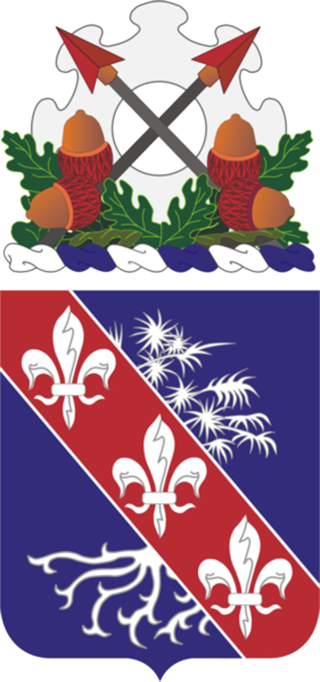
The 327th Infantry Regiment is an infantry regiment of the 101st Airborne Division of the United States Army. During World War II, the 327th was a glider-borne regiment of the 101st Airborne Division. It fought during World War I as part of the 82nd Division. It has also been deployed in the Vietnam War, Gulf War, and most recently to Iraq and Afghanistan. The song "Glider Rider" describes (humorously) some of the slights that glider-borne troops felt they received from the Army during World War II; though the regiment's public fame rose with the 1949 movie Battleground about the Siege of Bastogne in late 1944.

The U.S. 60th Infantry Regiment is a regimental unit in the United States Army. Its 2nd and 3rd Battalion conduct Basic Combat Training.

The 317th Infantry Regiment was a regiment of the United States Army during World War II. It was one of three infantry regiments in the 80th Infantry Division. Today, it is known as the 317th Regiment and is based in Lynchburg, Virginia as a training unit within the United States Army Reserve - currently under the 104th Training Division.

The 205th Infantry Brigade, was first formed as part of the United States Army Reserve's 103rd Division. It was active from 1921 to 1942 and then from 1963 through 1994, and then reformed in 2006.

The 17th Infantry Regiment is a United States Army infantry regiment. An earlier regiment designated the 17th Infantry Regiment was organized on 11 January 1812, but it was consolidated with four other regiments as the 3rd Infantry in the post-war reorganization of the army following the War of 1812, due to the shattering losses it sustained at the River Raisin. The current 17th Infantry was constituted as the 17th Regiment of Infantry on 3 May 1861.

The 36th Infantry Regiment is a United States Army infantry regiment.
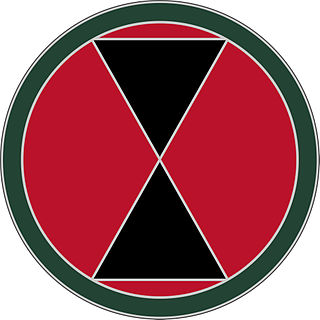
The 2nd Brigade, 7th Infantry Division, originally known as the 13th Infantry Brigade was an infantry brigade of the United States Army, and a part of the 7th Infantry Division. The brigade was based at Fort Ord, California for most of its history.
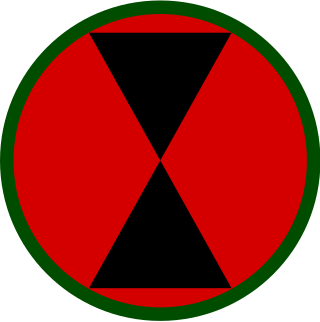
The 3rd Brigade, 7th Infantry Division, originally known as the 14th Infantry Brigade was an infantry brigade of the United States Army, and a part of the 7th Infantry Division. The brigade was based at Fort Ord, California for most of its history.
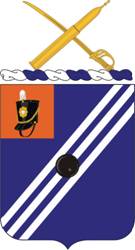
The 76th Field Artillery Regiment is a field artillery regiment of the United States Army. First formed as a cavalry regiment in 1916, the regiment was converted to field artillery in 1917, and served in Europe during World War I with the 3rd Division and as a separate battalion during World War II, as well as in peacetime at Fort Knox, KY, and Fort Devens, MA. Since 1959, the regiment has been a parent regiment under the Combat Arms Regimental System and the U.S. Army Regimental System, with regimental elements serving with the 3rd Infantry Division in Germany and Operation Iraqi Freedom, with the 7th Infantry Division in Korea, and in the Army Reserve. No regimental elements are currently active.
The 377th Field Artillery Regiment is a field artillery regiment of the United States Army. A parent regiment under the U.S. Army Regimental System, the regiment's 2nd Battalion, 377th Field Artillery Regiment is assigned to the 2nd Infantry Brigade Combat Team (Airborne), 11th Airborne Division. Elements of the regiment have also served with the 101st Airborne Division and 82nd Airborne Division, and have seen service in World War II, Vietnam, and in both Iraq and Afghanistan during the Global War on Terror. The 1st and 3rd Battalions as well as Batteries D and E are Inactive.

The 40th Armor Regiment was an armored regiment of the United States Army until the inactivation of its last element, its 1st Battalion, in 1996. It was redesignated and reactivated in 2005 as the 40th Cavalry Regiment and assigned to the 4th Brigade (ABN) 25th infantry division and in 2022 to the 2nd Infantry Brigade Combat Team (Airborne), 11th Airborne Division.
The 415th Regiment is a regiment of the United States Army Reserve.
The 340th Infantry Regiment was a National Army unit first organized for service in World War I as part of the 85th Infantry Division in Europe. Since then it has served as a training regiment, training Army Reserve and Army National Guard soldiers fighting in the War in Afghanistan (2001-2021) and the War in Iraq.
The 351st Infantry Regiment was a National Army Infantry Regiment first organized for service in World War I as part of the 88th Infantry Division in Europe. It later served in the Mediterranean Theater during World War II. Since then it has served as a training Regiment, training Army Reserve and Army National Guard Soldiers for service overseas after the September 11 terrorist attacks.


